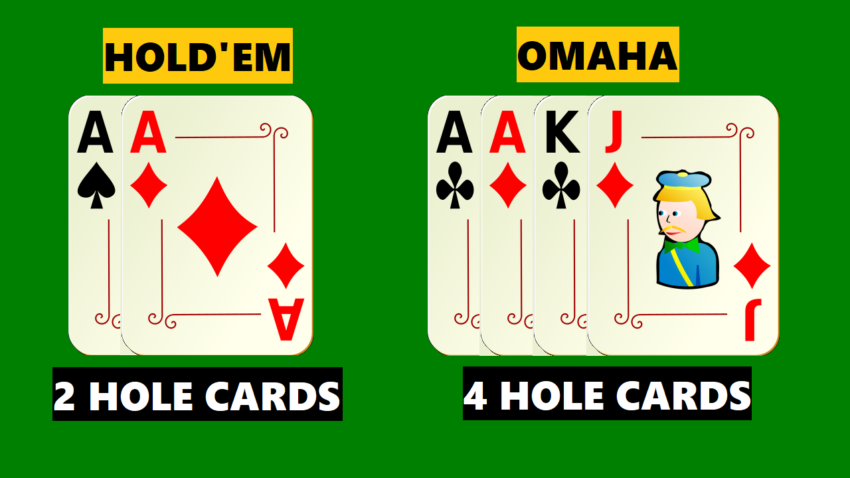DIFFERENCES BETWEEN HOLD’EM AND OMAHA
For this blog post, I hope to clarify the main gameplay and strategy differences between No-Limit Texas Hold’em and Pot-Limit Omaha. This is a must-read if you are just learning PLO for the first time or you need a refresher. I would also assume you already know the general rules of Hold’em, some beginner strategy, and have played a few Hold’em games yourself.
RULE CHANGES
There are not many differences between the two games, but those differences are enough to warrant a completely new approach to the game of Omaha. Here are the key differences between PLO and NLHE.
⦁ Four cards are dealt to each player instead of two: When it comes to the mechanics of dealing a game of Omaha, this is the only change when compared to Hold’em. There are still a flop, turn, and river, for a total of five community cards to be dealt face-up in the middle. There are also still a total of four betting rounds. Players now start with four hole cards to help them make their best poker hand, with the following restrictions as explained in the next bullet point.
⦁ You must use exactly 2 of your 4 hole cards along with 3 of the 5 community cards to make your best 5-card poker hand: Beginners are prone to forgetting this rule the most. In Hold’em, we are used to using any combination of 7 cards to make our poker hand. We could use both hole cards, just 1 hole card, or none at all, combined with using any 3, 4, or all 5 community cards. You cannot do this in Omaha! You have to use exactly 2… and only 2 of your 4 hole cards. Not 3, not even 1! It must be exactly 2!
⦁ The maximum bet on your turn is equal to the size of the pot on your turn: In No-Limit Hold’em, on your turn you can bet any amount of chips up to your entire stack. Omaha on the other hand is almost always played with a pot-limit betting structure, capping the amount that a player can bet to whatever number of chips are already in the middle. While that does mean that the maximum possible bet increases as more chips are put into the pot, it has a major effect on strategy as it prevents a player with at least a medium-sized stack from pushing all of their chips in immediately at the beginning of a hand.
EXAMPLE HAND
To help you understand bullet point #2, let’s go over an example hand. First we will start with a typical No-Limit Hold’em hand. You have AcJh and the board reads 7c Tc 8d 3c Kc.
This one is easy; you have an ace-high flush! Your ace combined with the seven, ten, three, and king, all clubs.
Now let’s take a look at an Omaha hand. Your hole cards are AcKhQd7d. The five community cards are Tc Jc 8c 7c 2d. What is your hand?
Remember the rule above, you must use exactly 2 hole cards with 3 community cards to make your best hand. Do you have a flush? Nope! You only have 1 club in your hand, the ace. You need a second club amongst your other hole cards in order to have a flush. You do not have a straight either! You have an ace, king, and queen, but you can only choose two of them. There is a jack and ten on the board, but no nine or another queen, king, or ace to help you complete the straight. Your best possible hand in this example is only a pair of sevens with an ace kicker, using your ace and seven along with the seven, ten, and jack that is on the board.
STRATEGY ADJUSTMENTS
Pot-Limit Omaha strategy can be a whole separate discussion for a future video or blog post. To keep things brief, here are a couple of important adjustments you should make when transitioning to PLO.
⦁ Play with hands that connect well: With four hole cards in PLO, a player has as many as six unique combinations of two cards that he or she can work with. In Hold’em, there is only one unique hand of two cards since each player is only dealt two cards. To increase the likelihood of having the best hand at showdown, you want starting hands where all four of your hole cards help you. A hand like JT98 is great for making straights, or two pair with a straight draw, offering the ability to improve to a straight or a full house. Pocket aces can be made stronger or weaker depending on the other two cards that accompany them. AhAcKhJc is a strong hand because not only do you have pocket aces, but also AK and AJ, which can help make the nut straight. Your aces are also double-suited. Since you also have AK of hearts and AJ of clubs, you have double the chance of making a flush, in this case the nut flush! On the other hand, a hand like AdAs8h3c is weak because you cannot make a flush and the only straight draw is A3, which will likely lose to a better straight.
⦁ Hands are stronger at showdown; watch out for the nuts: With more hole cards comes stronger hands compared to Hold’em. Also a player is more likely to hold the best possible hand in that moment. While it is possible to win a pot with just top pair, top kicker in Hold’em, that won’t be enough in Omaha. If you are playing against just one player (heads-up), two pair is the bare minimum that you want to have. On a full table, you most likely need to have at least a straight to win the pot at showdown. The higher the straight, flush, or full house, the better. If you do not have the nuts, you will want to watch out for a player that possibly does and play accordingly to your best judgement.
Hope this article helps you as you begin your Omaha adventure. If you have any further questions, feel free to ask me in the comment section of the associated video, or you can join the discord server and ask me there directly.





